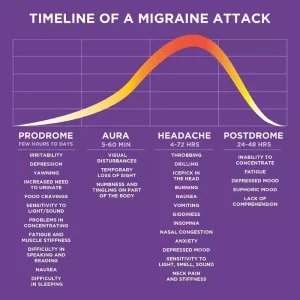Articles
Migraine is Not “Just a Headache”

Migraine is a neurological disorder whereas headache is a symptom.
As an employer, how do you respond when an employee says they have migraine? If it’s one of the following responses, your employees may not feel like they have your support, even if your intentions were good.
- – “Take an ibuprofen and get back in there!”
- – “Have you tried drinking more water?”
- – “Oh, I get headaches, too.”
Migraine is a complex, debilitating neurological disease. 1 It’s the leading cause of disability in the US for people under 50. 2 And yet people living with this disorder are continuously belittled with the above comments and the stigma of migraine. These misconceptions are so pervasive that people feel the need to hide this disease, especially at work. 3
Why is there confusion about migraine versus headache?
1- 40% of those who have migraine haven’t been diagnosed. This is largely due to the stigma of migraine, awareness, lack of research, low funding, and under diagnosis.
2- Migraine has a wide range of severity. While one person may have mild symptoms on rare occasions, another person may have severely disabling symptoms on a continuous basis. Those with mild symptoms may be able to ‘power through’ their attacks and may thus unjustly assume everyone else should also be able to easily manage migraine.
3- A painful headache is often mistaken for migraine. The perception that any painful headache is classified as a migraine attack undermines the fact that migraine is a genetic, neurological disease with dozens of unique symptoms. Over 70% of people will experience a tension headache at some point in their life. 4 While many headaches- including tension headache- can be quite painful, not all of these headaches are actually a sign of migraine.
4- Migraine is not well understood. Very few people without relatively severe migraine know that it is a specific disease. Even fewer people know about more rare symptoms such as temporary paralysis or slurred speech. This misunderstanding even exists amongst medical professionals, as undergraduate medical school only provides less than four hours of headache education. 5 If an individual doctor does not seek out additional training, it is unlikely that they will understand the complexities and severity of this condition.
5- You can’t see migraine or headache. Many of the symptoms of both migraine and headache are invisible to others, especially to those who do not know to look for them. When somebody does not have visible signs like a cast or a bruise, it is more likely that other people may discount their pain and assume they are faking or exaggerating. 6
6- Some individuals seek attention or sympathy. Some people fake or exaggerate medical conditions to get out of certain duties or simply to be noticed. An “invisible” condition like migraine may be easier to fake. This may lead others to dismiss those truly experiencing these symptoms. It should be noted that those with migraine are far more likely to fake being well than to fake being sick.
Well, if it’s not a headache, then what is migraine?
Migraine is a neurological disease which can affect the entire body 7 . It is a disease that spans a broad spectrum of severity and frequency. In some cases it can be mild and infrequent and for around 3-5% of people it can be frequent, painful and disabling. There is no cure for migraine, and it affects everyone differently.
An acute migraine attack refers to the attack itself while the disease is referred to as migraine. 8
Common symptoms include:
- – Head pain. While this one is obvious, the severity and quality of this pain can vary between individuals, and even between attacks. 9 This pain alone can completely disable a person.
- – Nausea and vomiting 10
- – Light/ sound/ scent/ taste/ touch sensitivity 11
- – Intolerance to movement 12
- – Fatigue 13
- – Musculoskeletal Pain (Neck, jaw, shoulder, sinuses, etc.), numbness, and/ or tingling 14
- – Tinnitus 15
- – Dizziness and vertigo 16
- – Gastrointestinal issues (diarrhea, constipation, etc.) 17
- – Cognitive issues (brain fog; issues with concentration, memory, and word finding)
- – Autonomic symptoms (chills/ hot flashes; eye redness/ tearing; sinus pressure) 18
- – Less common symptoms include stroke-like symptoms such as paralysis; loss of vision; impaired consciousness 19
Migraine can affect the way the brain interprets stimuli from every one of the senses during an attack. Lights are brighter (photophobia.) 20 Sounds are louder (phonophobia.) 21 Tastes and smells are sickening (osmophobia.) 22 Light touch may become unbearable (allodynia.) 23
There are multiple phases of a migraine attack
In a typical migraine attack, there are several phases called the prodrome, aura, headache/ attack phase, and postdrome or the “migraine hangover.” Not every person experiences every phase, and these phases can overlap. This infographic created by the American Migraine Foundation helps break down some of the common symptoms amongst the distinct phases of a migraine attack.
Migraine debilitation is a spectrum
Migraine disease also exists on a spectrum, meaning people experience it in different frequencies and levels of debilitation. 24 Episodic migraine attacks occur from 14 days per month to very seldomly. Chronic migraine attacks occur from 15 days per month and upwards, with some people never receiving relief. Symptoms range from mild to disabling, so even people also living with migraine may not be able to comprehend the true disability experienced by others.
90% of people cannot function normally during a migraine attack. 25 Managers in your organization who lead with compassion and understanding are more likely to get the best results from their team. Discuss the needs of your staff, consider whether any simple accommodations may be helpful, and work with them to remove any barriers to achieving their full potential.
Other key points about migraine:
- – It’s a Diversity, Equity, and Inclusion (DEI) issue. Migraine disproportionately affects women, people of color, veterans, and people with disabilities.
- – Migraine costs companies large amounts of money, even though these costs tend to be hidden and unknown by many employers.
- – Simple accommodations and educational programs can support employees in the workplace, increase productivity, and show positive return on investments.
Learn more from real people working with migraine disorder:
- – Staying Productive While Combating Migraine: A Patient’s Perspective by Pratyusha Ghoshal Roy
- – An Educator with Migraine, Educating about Migraine at Work by Bruce Shaw
- – The Show Must Go On; Kristin Chenoweth Describes Performing with Migraine
(Alt text of the AMF infographic: Timeline of a Migraine Attack. Prodrome: few hours to days- irritability, depression, yawning, increased need to urinate, sensitivity to light/ sound, problems in concentrating, fatigue and muscle stiffness, difficulty in speaking and reading, nausea, difficulty in sleeping. Aura: 5-60 minutes- visual disturbances, temporary loss of sight, numbness and tingling on part of the body. Headache: 4-72 hours- throbbing, drilling, icepick in the head, burning, nausea, vomiting, giddiness, insomnia, nasal congestion, anxiety, depressed mood, sensitivity to light smell and sound, neck pain and stiffness. Postdrome: 24- 48 hours- inability to concentrate, fatigue, depressed mood, euphoric mood, lack of comprehension.)
1)Goadsby, et al, 2018, Pathophysiology of Migraine: A Disorder of Sensory Processing, Physiological Reviews, <https://www.ncbi.nlm.nih.gov/pmc/articles/PMC5539409/>
2)Steiner, et al, 2018, Migraine is first cause of disability in under 50s: will health politicians now take notice?, Journal of Headache and Pain, <https://www.ncbi.nlm.nih.gov/pmc/articles/PMC5821623/>
3)Glaser, 2021, Hidden Pain: Migraine Stigma at Work Is a Big Problem, Migraine Again, <https://www.migraineagain.com/migraine-stigma-at-work/>
4)World Health Organization. Lifting the Burden. ‘Atlas of headache disorders and resources in the world 2011.’ WHO Press. 2011.
5)Young, et al, 2007, Square One: Headache Education for the Medical Student, Headache, <https://americanheadachesociety.org/wp-content/uploads/2018/07/Medical_Student_Curriculum.HED_.March_.07.pdf>
6)Dobson, 2021, Invisible Illness and Measurability, AMA Journal of Ethics, <https://journalofethics.ama-assn.org/article/invisible-illness-and-measurability/2021-07>
7)2021, Migraine is a Whole Body Disease Infographic, Migraine and Headache Policy Forum, <https://static1.squarespace.com/static/5886319ba5790a66cf05d235/t/6036bf5eba009a5866faeea0/1614200672047/HMPF__MigraineWholeBody_Infographic_Feb2021.pdf>
8)HEADACHE & MIGRAINE DISEASE LANGUAGE & IMAGE GUIDE, CHAMP, <https://headachemigraine.org/wp-content/uploads/2021/01/Lang_Image_Guide_Handout_web.pdf>
9)Wang, et al, 2017, Headache symptoms from migraine patients with and without aura through structure-validated self-reports, BMC Neurology, <https://bmcneurol.biomedcentral.com/articles/10.1186/s12883-017-0973-4>
10)Dunleavy, 2021,What Is Migraine? Symptoms, Causes, Diagnosis, Treatment, and Prevention, Everyday Health, <https://www.everydayhealth.com/migraine/guide/>
11)Dunleavy, 2021,What Is Migraine? Symptoms, Causes, Diagnosis, Treatment, and Prevention, Everyday Health, <https://www.everydayhealth.com/migraine/guide/>
12)Furman & Marcus, 2012, Migraine and motion sensitivity, Continuum, <https://pubmed.ncbi.nlm.nih.gov/23042062/>
13)2018, The Timeline of a Migraine Attack, American Migraine Foundation, <https://americanmigrainefoundation.org/resource-library/timeline-migraine-attack/>
14)Cuadrado, et al, 2008, Migrainous corpalgia: body pain and allodynia associated with migraine attacks, Cephalagia, <https://pubmed.ncbi.nlm.nih.gov/18021265/>; Dunleavy, 2021,What Is Migraine? Symptoms, Causes, Diagnosis, Treatment, and Prevention, Everyday Health, <https://www.everydayhealth.com/migraine/guide/>
15)Doherty, 2021,, The Link Between Migraines and Tinnitus
Buzzing or ringing in your ears could be related to your episodes, Verywell Health, <https://www.verywellhealth.com/link-between-migraines-and-tinnitus-4077631>
16)Upham, 2021, What You Need to Know About Migraine and Vertigo, Everyday Health, <https://www.everydayhealth.com/migraine/what-you-need-to-know-about-migraine-and-vertigo/>
17)Upham, 2021, The Link Between Migraine Headache and Diarrhea, Everyday Health, <https://www.everydayhealth.com/migraine/the-link-between-migraine-headache-and-diarrhea/>
18)2015, Flushing, Drooping, Tearing, and Stuffiness… Autonomic Symptoms in Headache, American Migraine Foundation, <https://americanmigrainefoundation.org/resource-library/autonomic-symptoms-in-headache/>
19)2017, Hemiplegic Migraine, American Migraine Foundation, <https://americanmigrainefoundation.org/resource-library/hemiplegic-migraine/>
20)Wilkins, et al, Photophobia in migraine: A symptom cluster?, Cephalagia, <https://pubmed.ncbi.nlm.nih.gov/33990148/>
21)Kalita, et al, 2021,Phonophobia and brainstem excitability in migraine, European Journal of Neuroscience, <https://pubmed.ncbi.nlm.nih.gov/33305448/>
22)Albanês Oliveira Bernardo, et al, 2020, Osmophobia and Odor-Triggered Headaches in Children and Adolescents: Prevalence, Associated Factors, and Importance in the Diagnosis of Migraine, Headache, <https://pubmed.ncbi.nlm.nih.gov/32293736/>
23)Young, 2009, Allodynia as a complication of migraine: background and management, Current Treatment Options in Neurology, <https://pubmed.ncbi.nlm.nih.gov/19094830/>
24)Aurora, 2009, Spectrum of illness: understanding biological patterns and relationships in chronic migraine, Neurology, <https://pubmed.ncbi.nlm.nih.gov/19188565/>
25)Migraine Facts, Migraine Research Foundation, <https://migraineresearchfoundation.org/about-migraine/migraine-facts/#:~:text=While%20most%20sufferers%20experience%20attacks,function%20normally%20during%20their%20migraine.>

